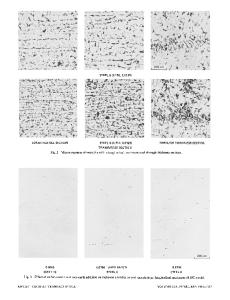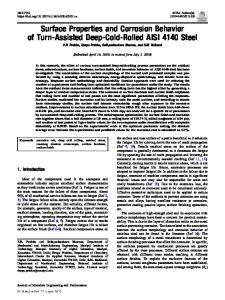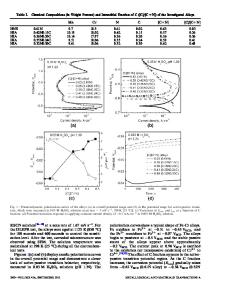Corrosion properties of rolled products made of new low-alloy high-strength steels
- PDF / 846,996 Bytes
- 7 Pages / 612 x 792 pts (letter) Page_size
- 93 Downloads / 337 Views
CORROSION PROPERTIES OF ROLLED PRODUCTS MADE OF NEW LOW-ALLOY HIGH-STRENGTH STEELS O. V. Rabinovych,1 V. S. Vakhrusheva,2 T. O. Derhach,2 L. S. Severina,2 A. V. Puchykov,3 H. M. Trehubenko,1 M. S. Khoma,4 H. M. Krutsan,4 and O. V. Uzlov 3
UDC 620.194
It is shown that, in terms of the corrosion rate in the atmosphere, corrosion resistance in numerous acid, alkali, and salt solutions, corrosion-cracking resistance, and corrosion-fatigue resistance, the rolled products made of G2S- and KhS-type low-alloy high-strength steels with carbonitride hardening are on the same level as (or even better than) the rolled products of 09G2D commercial steel of lower strength used in the construction of railway cars.
Numerous new requirements imposed on the rolled products for contemporary machine building, civil engineering, and other branches of industry must guarantee the possibility of long-term operation of these products without accidents and repairs and decrease the costs of scheduled maintenance and overhauls of the structures. Parallel with high strength and plasticity, new structural materials must have satisfactory corrosion resistance under the atmospheric conditions and certain levels of resistance to general and local corrosion, corrosion-cracking (CC) resistance, and corrosion-fatigue resistance [1]. The aim of the present work is to perform comprehensive comparative corrosion investigations of rolled products made both of new G2S- and KhS-type low-alloy high-strength steels with carbonitride hardening and of 09G2D reference steel and give recommendations concerning the possibility of application of these types of steel in critical structures. Materials and Procedure of Investigations We tested specimens of experimental rolled products of G2S-type (heats 123, 167, and 245) and KhS-type (heat 198) steels with carbonitride hardening microalloyed with aluminum, titanium, and nitrogen (these steels were melted at the Petrovs’kyi Dnipropetrovs’k Metallurgical Works and rolled into sheets and channels) and specimens of the rolled products of 09G2D reference steel. The mechanical properties of the rolled products of the experimental types of steel satisfy the requirements of OST 32.153 (see Table 1). The microstructure of steels is formed by fine ferritic-pearlitic grains of grade 8–9 according to GOST 5639-82 (Fig. 1a). In view of the restricted possibilities of production, the experimental steels were melted in furnaces with acid lining, which led to the formation of manganese sulfides in the structure of steels. In the process of deformation, these sulfides became elongated in the direction of rolling (Fig. 1b). 1 Ukrainian National Metallurgical Academy, Dnipropetrovs’k. 2 Osada Pipe Scientific-Research Institute, Dnipropetrovs’k. 3 Nekrasov Institute of Ferrous Metallurgy, Ukrainian Academy of Sciences, Dnipropetrovs’k. 4 Karpenko Physicomechanical Institute, Ukrainian Academy of Sciences, Lviv.
Translated from Fizyko-Khimichna Mekhanika Materialiv, Vol. 42, No. 5, pp. 108–112, September–October, 2006. Original arti
Data Loading...











